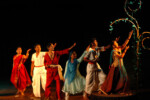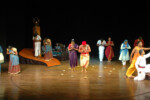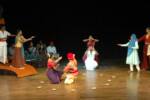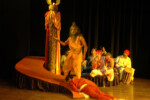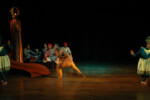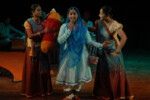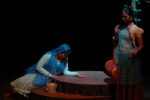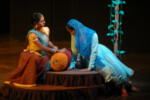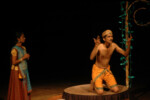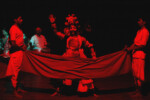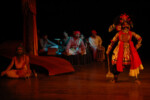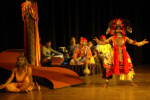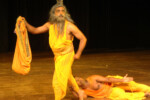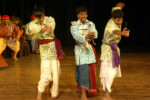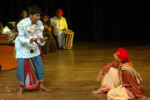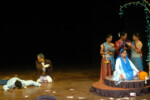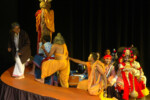PLAYWRIGHT : K V SUBBANNA DESIGN & DIRECTION : MOUNESH L BADIGER MUSIC : GAJANANA HEGDE
SYNOPSIS :
Timeline: Speculated to be authored around the 6th or 7th century B.C., when Buddhism had started to decline from the pinnacles that it had reached and the Vedic religions had begun to gain popularity. It was a time when the boundaries, created by the high intellect &naatya dharma based content of Sanskrit based theatre space, were beginning to get demolished by newer, revolutionary & socially relevant concepts portrayed in an entertaining fashion that would find wider acceptance among the general public. Traces of this shifting trend can be found scattered across this literary work.
Author: The play is constructed based on K V Subbanna’s “SooleSanyasi”, which utilized different technical aspects of the folk art YakshaGaana to give a new spin to the Sanskrit play “Bhagavadajjukeeyam”. Not much is known about the root author of “Bhagavadajjukeeyam”. Some guess this as a work of Bhaasa and yet others claim this to be a work of a poet called “Bhodaayana”.
Play: Though on cursory look, this seems to be a naughty, orphan disciple trying to dodge his guru to drown in worldly, materialistic pleasures, on a deeper level; it seems to be a guide to our prevalent education system. On one side, through the evident ‘guru to disciple’ & indirect ‘disciple to guru’ transmission of knowledge it seems to propagate the unique message of “awareness is the true guru”.
On the other, when bringing society’s adverse nature and mentality’s two spheres (spiritual & intellectual) face-to-face at the same time looks dangerous in today’s times, what kind of an impact it would have had hundreds of years back is anybody’s guess.
There is the thought of the sage, seated under the tree’s shade, wrapped in saffron attire in the midst of his meditation, of how it would feel if it was possible for him to excite the very ground that he sets foot on like VasanthaSena. Similarly there is the courtesan, VasanthaSena’s thought of how it would feel to be able to be rid of the want for materialistic belongings. These two contrasting thoughts truly reflect the deep inner feelings of these two personalities. Further when the souls of the sage and the prostitute get interchanged, though the incident seems coincidental, the meaning arising out of the incident is neither coincidental nor simple.
Finally the play attains an ending of a new beginning VasanthaSena come face-to-face with the entire cast (society) who set out to attain salvation by surrendering to the guru called awareness and gaining freedom from the jungle of feelings.
CAST DETAILS
| Bhagavatha | Renuka Prasad H S |
| Shandilya | Anand P |
| Parivrajaka | Raghavendra Prasad C |
| Kohala | Navin B Joshi |
| Vasanthasene | Monisha |
| Parabrithike | Ashwini V |
| Madhukarike | Tanuja R |
| Yamapurusha | Manjunath L Badiger |
| Ghatasarpa | Srinivas Prasad C |
| Navilu / Mela / Ramilaka | Harish R |
| Kuduka / Mela | Gopi |
| Navilu / Kuduka / Mela | Ronald Kiran |
| Vasanthasene’s Mother | Vasundhara |
| Doctor | Parameshwara K |
BACK STAGE
| Music Direction | Gajanana Hegade |
| Chorus | Suma G A |
| Shwetha S | |
| Chande | Shankar Balekudru |
| Percusssions | Raghavendra K |
| Key Board | Veeresh M P M |
| Stage | Nagaraj M |
| Dhananjay B | |
| Costumes | Bharath B S |
| Tanuja R | |
| Vasundhara S P | |
| Make-up | Raghavendra Prasad C |
| Art | Veeresh M P M |
| Management | Manjunath M S / Dhananjay B / Madhu Kumar |
| Lighting | Ravindra Poojary |
| Organising | Jayathirtha |



